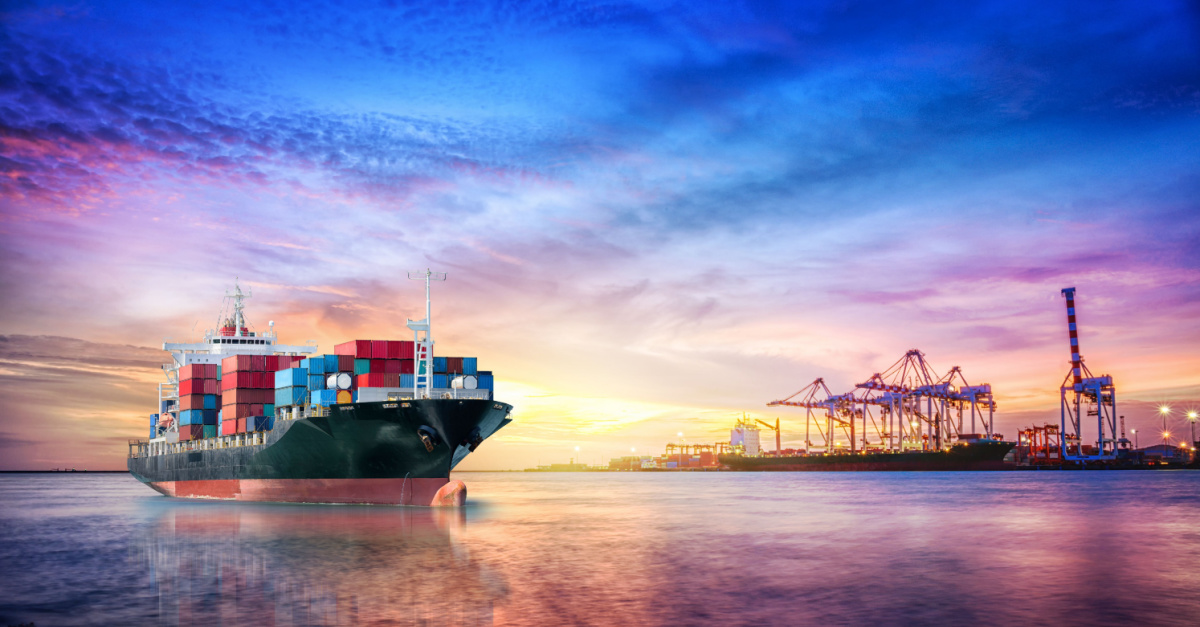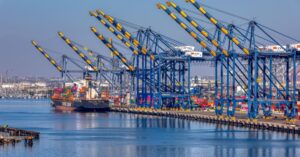The world of ocean freight has had an interesting couple of years. From a near standstill in early 2020 during the initial pandemic lockdowns, ocean shipping exploded along with e-commerce as shut-in consumers used it as a lifeline for everyday essentials. Spot rates shot through the ceiling, touching $30,000+ per container in 2021 as demand way outstripped capacity and dozens of cargo ships sat at anchor at LA/Long Beach.
After the boom cycle driven by trillions in government COVID-19 relief subsided in 2022, and inflation persisted, the supply/demand balance slipped the other way. Ocean freight shipping volumes saw a steady decline for several quarters, but have recently been ticking up, per the Descartes index.
Suffice it to say, shippers face a very volatile, unpredictable ocean freight logistics market these days. In addition to a sketchy macroeconomic picture, there’s a major conflict in Israel and a renewed environmental push from regulators. Now, months after a hard-fought ILWU settlement on the West Coast, there are rumblings of labor issues on the East/Gulf ports right in time for the 2024 elections.
Ocean Shippers Face a High-Stress Environment
As shippers contend with these and other challenges in a volatile market, the peace of mind needed to operate confidently in the high-stakes world of global freight can prove elusive.
In the crucible of this extremely stressful situation, shippers face a daily struggle to build reliable operations in a dynamic environment that seems to grow more volatile.
And reliable, dependable operations are exactly what is needed to keep the supply chain moving and inventories stocked. The margin of error is razor thin, and much is riding on the ability of inbound transportation managers to navigate the complex interplay of suppliers, carriers, forwarders, brokers, and regulators.
Poor Visibility into High-Stakes Operations
Inclement weather, port delays, and incidents like the ongoing Panama Canal drought – which is so bad a Japanese company paid nearly $4 million recently to jump the line – point to the insufficiency of relying on visibility data from carriers and port authorities.
Even with data feeds on ocean freight visibility, most forwarders still need to enter it manually into their systems. This puts a crimp in shippers’ ability to gain real-time updates on cargo location, frustrating them and defeating the whole purpose.
In a February 2023 survey of 350 supply chain professionals from FourKites, half of them reported having zero visibility into their ocean freight, with more than 20% relying on manual track-and-trace processes to locate their shipments.
Shippers lacking visibility are struggling to develop insights that can drive intelligent decision-making while cargo is in transit. It not only inhibits their ability to make last-minute, high-stakes decisions in a dynamic environment, but it also limits the big-picture operational understanding necessary for long-term planning.
Unreliable Communication Strategies
Poor communication in any organization is a sure recipe for failure, or at best, sub-par performance, as key messages are delayed or lost. In the world of ocean freight, where precision is everything, a communication strategy that’s not up to snuff gets costly in a hurry. Sailings are delayed, stress mounts, and orders go unfulfilled.
Supply chain disruptions come in all shapes and sizes, causing a domino effect. From January to June 2023, supply chain disruptions were up 3% globally vs. the prior year, according to a Resilinc survey.
Since snags can pop up anywhere and anytime along major shipping lanes, such as the 2021 Ever Given fiasco in the Suez Canal, shippers must have a reliable means of understanding each container’s precise location and status. Despite increasing disruptions, many shippers still rely on outdated strategies like fax, email, and phone calls to track the progress of their freight.
Dynamic Freight Landscape
The ebb and flow of ocean freight traffic and volumes, based on economics and labor issues, creates a very elastic environment for shippers. Prior to the pandemic in 2019, volumes had been shifting from West Coast to East and Gulf Coast ports, as the widening of the Panama Canal made the passage more economical.
Then, after COVID-19 hit and e-commerce boomed, volume shifted back to key West Coast ports like LA/Long Beach and SeaTac, due to shorter sailing times from Asia. Alas, this led to clogged ports and dozens of ships at anchor waiting for a berth, so shippers again diverted cargo back east. This shift was exacerbated in the first half of 2023 by concerns over potential labor shutdowns at West Coast ports as union negotiations dragged on.
With an ILWU contract in place as of August, the Panama Canal drought limiting passage, and rumblings of East Coast labor discontent next year, volumes are shifting west again. All of this shuffling and reshuffling affects everything from port congestion to drayage efficiency and the potential for higher demurrage and detention (D&D) charges. Put together, it spells significant challenges and a cloud of uncertainty for shippers.
Given These Challenges, Shippers Seek Peace of Mind
With all these factors in play, the process of coordinating international pickup and transport of ocean freight will only continue to grow in complexity and cost. This unsettling scenario is driving shippers to seek reliable solutions that address their transportation challenges now and in the future and deliver peace of mind. Yes, it is possible!
How is this result achieved, even in the midst of significant market disruptions? By engaging with an ocean freight solution partner that listens, communicates, and executes through the use of advanced technology, solid partnerships, and deep industry experience. Here are some ways COGISTICS Transportation makes it happen:
Ocean Freight Visibility
COGISTICS Transportation provides industry-leading solutions for enhancing your cargo visibility, both inbound and outbound.
With shipment tracking across your ocean operations, you can improve reactivity to issues as they arise and get a data-driven understanding of your operational status. With COGISTICS Transportation, all shipments are tracked in a consistent manner and presented in a simple, easy-to-access dashboard view. We also deliver deep insights that help you drive continuous improvement in your ocean freight operations and strategy.
With this information, your organization can track and manage shipments more effectively. Inventory accuracy is improved, boosting sales and customer satisfaction, and coordination with carriers, freight forwarders, and brokers.
Integrated Communication
In addition to providing 24/7 tracking of all shipments, with location-on-demand precision, COGISTICS Transportation also offers always-on access to a freight expert to help you quickly address any issues you’re facing.
Tracking and status updates are provided throughout the entire shipment journey, from initial order to delivery. Our dashboard gives you a high degree of granularity for every container in transit from gate to gate, including the cargo vessel it’s on, the ship’s speed and the weather it’s encountering.
COGISTICS Transportation also works to simplify and streamline the required documents and process for all your shipments. We coordinate closely with your freight broker every step of the way and get ahead of any issues that arise.
Expert Guidance in Uncertain Times
To literally navigate through industry uncertainty and ensure the efficient movement of ocean freight, you need a trusted, experienced partner who can provide consistency, transparency, and flexibility. COGISTICS Transportation is that partner!
With a heritage in logistics stretching back to the 1980s, COGISTICS Transportation is licensed as an Ocean Transportation Intermediary (OTI) and a Non-Vessel-Operating Common Carrier (NVOCC) by the Federal Maritime Commission (FMC).
COGISTICS Transportation utilizes 24/7 collaborative communication to help companies achieve both operational and financial objectives. Our professional teams provide deep analysis of multi-point transportation data to develop and implement supply chain initiatives domestically and internationally. We provide best-in-class freight brokerage, freight forwarding, freight management, and 3PL services on land, sea, and air.
COGISTICS Transportation: People-Powered Peace of Mind
COGISTICS Transportation removes stress and simplifies your transportation and logistics operations. User-friendly technology, around-the-clock visibility, and decades of industry experience enable COGISTICS Transportation to back up its primary commitment: to give our partners a competitive advantage and deliver peace of mind.
With its unmatched freight visibility and integrated communication capabilities, COGISTICS Transportation delivers on this promise by seamlessly melding high-tech and high touch. We provide the unparalleled reach and technology expected of an industry-leading freight broker while maintaining the communication and personal responsibility of a family business. In a volatile environment, shippers need both.
Find Peace of Mind in Your Ocean Freight Operations with COGISTICS Transportation
Between fluctuating ocean freight capacities and costs, shifting port dynamics, war on two fronts, and the overall economic picture, there’s more than enough to keep shippers up at night. With COGISTICS Transportation in your corner, managing your ocean freight logistics doesn’t have to be one of them.
Advanced freight tracking and real-time shipment status. Data analytics and customized reports. 24/7 access to problem-solving experts. Freight brokerage and shipping management. Whatever the particular needs of your business and transportation operations, COGISTICS Transportation has you covered. Take the next step and contact us today!




